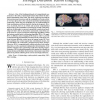Free Online Productivity Tools
i2Speak
i2Symbol
i2OCR
iTex2Img
iWeb2Print
iWeb2Shot
i2Type
iPdf2Split
iPdf2Merge
i2Bopomofo
i2Arabic
i2Style
i2Image
i2PDF
iLatex2Rtf
Sci2ools
TITB
2010
2010
Coclustering for cross-subject fiber tract analysis through diffusion tensor imaging
Abstract--One of the fundamental goals of computational neuroscience is the study of anatomical features that reflect the functional organization of the brain. The study of physical associations between neuronal structures and the examination of brain activity in vivo have given rise to the concept of anatomical and functional connectivity, which has been invaluable for our understanding of brain mechanisms and their plasticity during development. However, at present, there is no robust and accurate computational framework for the quantitative assessment of cortical connectivity patterns. In this paper, we present a quantitative analysis and modeling tool that is able to characterize anatomical connectivity patterns based on a newly developed coclustering algorithm, termed the business model-based coclustering algorithm (BCA). We apply BCA to diffusion tensor imaging (DTI) data in order to provide an automated and reproducible assessment of the connectivity patterns between different c...
Anatomical Connectivity Patterns | Connectivity Patterns | Cortical Connectivity Patterns | Education | TITB 2010 |
| Added | 22 May 2011 |
| Updated | 22 May 2011 |
| Type | Journal |
| Year | 2010 |
| Where | TITB |
| Authors | Cui Lin, Darshan Pai, Shiyong Lu, Otto Muzik, Jing Hua |
Comments (0)

